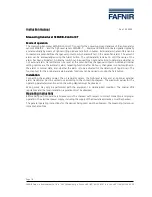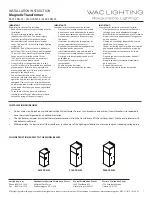
Acetylene transmitter E2618-C2H2 is a member of new PluraSens® family of
multifunctional measurement instruments. Applications include areas of welding,
cutting, heat treating, cylinder storage rooms and other confined spaces where
potentially explosive concentration of acetylene can accumulate.
The instrument utilises novel fully calibrated and temperature compensated
semiconductor metal oxide gas sensor with excellent repeatability, stability and
long lifetime.
The transmitter is supplied either in duct-mount or wall-mount version. For the wall-
mount version the range of remote probe options is available.
Two analog outputs and RS485 digital interface with industry standard Modbus
RTU protocol can be used to connect the transmitter to safety or building
automation systems.
Safety requirements
Always adhere to the safety provisions applicable in the country of use.
Do not perform any maintenance operation with the power on. Do not let water or
foreign objects inside the device.
Operating conditions
The device should be used in explosion-safe (non ATEX -rated) indoor areas,
without aggressive gases in the atmosphere. Allowed conditions are:
– temperature in the range of -40...+85 °C
– relative humidity in the range of 0...100%
– atmospheric pressure in the range of 80...1207 kPa.
Installation and connection
1. Duct mount version: Assemble the sensor probe and connect it to the device
main unit. Make sure that the connections are tightened properly.
Cut a 25 mm diameter hole in the air duct at the chosen mounting place. Fix the 25
mm cable gland in the hole. Pass the sensor probe through the gland, adjust it to
the appropriate depth and tighten the gland’s screw. Unscrew four lid screws and
detach the lid from the instrument.
Wall mount version: Unscrew four lid screws and detach the lid from the
instrument. Fix the transmitter through mounting holes by screws.
The device should be mounted in proximity to potential acetylene sources and
away from the ventilation holes or dead-air spaces such as corners. Acetylene is
slightly lighter than air (0,9 of air density) and tends to spread evenly in the room.
The sensor should be placed at 1,4...2 m from the floor. Recommended coverage
area for each transmitter is 50...100 m
2
(4...5,5 m radius).
2. Plug the power cable and connect the analog outputs and/or digital interface
terminals to the relevant devices according to the connection diagram.
Make certain that the cable gland is properly tightened to ensure the conformity to
IP65 protection class.
The screwless quick connect spring terminals on the E2618 series devices are
suitable for a wide range of wires with cross-section 0,2...1,5 mm
2
. The
recommended wire stripping length is 8...9 mm. Push the spring loaded terminal
lever, insert the wire end into terminal hole and release the lever.
Use twisted pair cable, e.g. LiYY TP 2×2×0,5 mm
2
or CAT 5, to connect the device
to RS485 network. Use one pair for A and B wires and the second pair for common
0 V and power +U wires. to connect the transmitter to Fieldbus network. Respect
polarity. Overall length of all connections via RS485 interface should not exceed
1200 m.
3. Place the lid back and tighten it with the four screws.
The type of each analog output can be independently changed between 4-20 mA
and 0-10 V with jumpers J1 (OUT1) and J2 (OUT2).
With closed jumper the output is 0-10 V, with open jumper the output is 4-20 mA.
By default both outputs OUT1 and OUT2 are assigned to gas concentration with
the scale 0 -25 000 ppm (0-100 % LEL/ 0-2,5 % vol) of acetylene C
2
H
2
. The device
has built-in temperature sensor which may be connected to any of the outputs.
The output assignments and scales can be changed by Modbus commands.
Sensor probe handling
The wall mount version of the transmitter is available with remote probe (see
drawing for dimensions).
The remote probe is connected to the main unit with shielded cable. The
connection cable length options are 3 m, 10 m or 25 m.
The sensor probes of all types are equipped with a hydrophobic microporous
PTFE filter to protect the sensor from dust, dirt and water drops. The round filter is
snap-fitted and may be replaced if it gets strongly contaminated.
To replace the PTFE filter, carefully hook the filter near it’s edge with a small flat
screwdriver and pull it off. Place a new filter onto the sensor opening and press it
to snap into the groove.
NB!
Never stab or press the filter near its center where the sensor is located since
this may damage the sensor.
The recommended orientation of sensor probe is vertical with the sensor tip
pointing downwards. This prevents possible accumulation of condensed water on
the sensor protection filter. The horizontal orientation is also suitable. Avoid upward
position of the sensor tip.
Sensor heating-up
For best stability the gas detector shall be powered permanently. If the instrument
is left for a long time in unpowered state, then after initial power-on the metal-oxide
gas sensor needs some time to heat up and burn adsorbed contaminants.
4-20 mA / 0-10 V
4-20 mA / 0-10 V
0V / GND
0V
Controller
Power Supply
Input 1
Input 2
OUT1
OUT2
0V
A
B
RS485
+U
J1 J2
Fieldbus
Sensor module
+12 V
J3
Dimensions of the E2618 wall-mount version
Dimensions of the E2618 duct mount version
Ø4 mm
55
80
13
0
82
50
70
36
77
Ø35...36
Ø50
120°
Ø6
5
80
3
27
Ø34 max
Hole
35
55
11
5
M16
82
80
Ø16






















